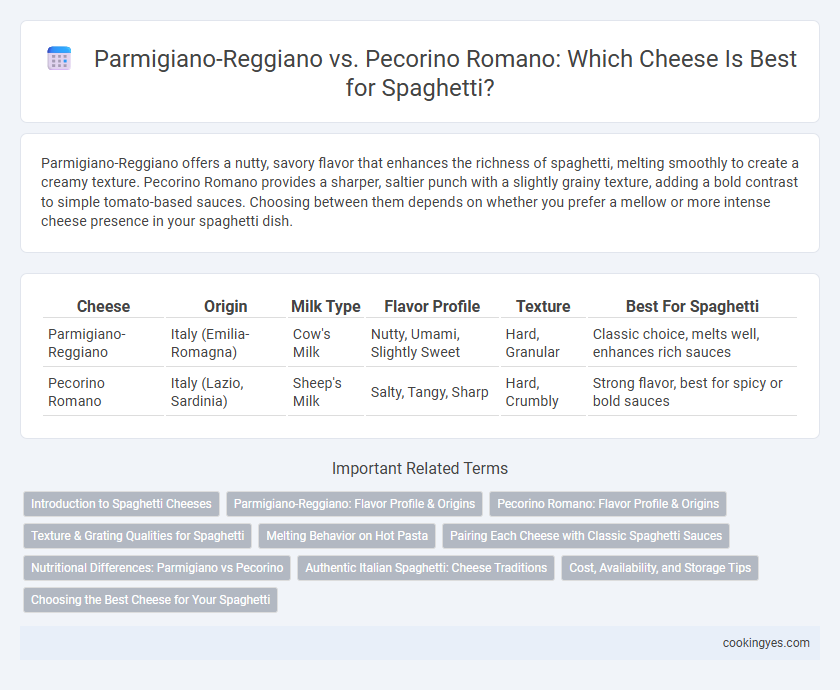Parmigiano-Reggiano offers a nutty, savory flavor that enhances the richness of spaghetti, melting smoothly to create a creamy texture. Pecorino Romano provides a sharper, saltier punch with a slightly grainy texture, adding a bold contrast to simple tomato-based sauces. Choosing between them depends on whether you prefer a mellow or more intense cheese presence in your spaghetti dish.
Table of Comparison
| Cheese | Origin | Milk Type | Flavor Profile | Texture | Best For Spaghetti |
|---|---|---|---|---|---|
| Parmigiano-Reggiano | Italy (Emilia-Romagna) | Cow's Milk | Nutty, Umami, Slightly Sweet | Hard, Granular | Classic choice, melts well, enhances rich sauces |
| Pecorino Romano | Italy (Lazio, Sardinia) | Sheep's Milk | Salty, Tangy, Sharp | Hard, Crumbly | Strong flavor, best for spicy or bold sauces |
Introduction to Spaghetti Cheeses
Parmigiano-Reggiano and Pecorino Romano are two iconic cheeses frequently used to enhance the flavor of spaghetti dishes. Parmigiano-Reggiano, a hard, granular cheese from Italy, offers a rich, nutty taste with a slightly salty finish, making it ideal for classic spaghetti recipes like Carbonara or Bolognese. Pecorino Romano, a sharper and saltier sheep's milk cheese, provides a bold flavor profile perfect for rustic spaghetti dishes such as Cacio e Pepe, adding depth and complexity to the sauce.
Parmigiano-Reggiano: Flavor Profile & Origins
Parmigiano-Reggiano, often called the "King of Cheeses," offers a rich, nutty flavor with granular texture that melts beautifully over spaghetti. Originating from specific regions in Italy such as Parma, Reggio Emilia, and Modena, its production follows strict traditional methods ensuring high quality and distinct taste. Compared to the sharper, saltier Pecorino Romano, Parmigiano-Reggiano provides a more balanced and creamy complement to spaghetti dishes.
Pecorino Romano: Flavor Profile & Origins
Pecorino Romano boasts a sharp, salty flavor with a crumbly texture, making it an ideal cheese to enhance the boldness of traditional Roman spaghetti dishes like Cacio e Pepe. Originating from the Lazio region of Italy, Pecorino Romano is a hard sheep's milk cheese aged for at least eight months, imparting a robust and tangy character distinct from the nuttier, creamier Parmigiano-Reggiano. Its intense, savory notes provide a striking contrast to the milder, sweet profile of Parmigiano-Reggiano, highlighting regional culinary heritage in Italian pasta recipes.
Texture & Grating Qualities for Spaghetti
Parmigiano-Reggiano offers a granular texture that grates finely, melting smoothly into spaghetti to create a creamy, cohesive sauce. Pecorino Romano has a harder, saltier texture with a coarser grate, providing a sharper flavor and a slightly crumbly finish on pasta. The choice depends on whether a milder, velvety melt or a robust, textured topping is preferred for the spaghetti experience.
Melting Behavior on Hot Pasta
Parmigiano-Reggiano melts smoothly on hot spaghetti, creating a creamy texture that enhances the sauce without overpowering it. Pecorino Romano, with its higher salt content and firmer texture, tends to melt less uniformly, offering a sharper, more granular finish on the pasta. Understanding their distinct melting behaviors helps in choosing the ideal cheese to complement different spaghetti styles and sauces.
Pairing Each Cheese with Classic Spaghetti Sauces
Parmigiano-Reggiano pairs exquisitely with tomato-based spaghetti sauces like marinara or Bolognese, enhancing the umami depth and adding a nutty, savory finish. Pecorino Romano complements aglio e olio or carbonara sauces, contributing a sharp, salty bite that balances the garlic and pancetta flavors. Choosing between these cheeses depends on the sauce's profile: Parmigiano-Reggiano for rich, hearty red sauces and Pecorino Romano for lighter, oil-based or creamy preparations.
Nutritional Differences: Parmigiano vs Pecorino
Parmigiano-Reggiano contains higher levels of protein and calcium, offering about 10 grams of protein and 331 mg of calcium per 30 grams, while Pecorino Romano provides more fat and sodium, with approximately 8 grams of protein but 920 mg of sodium per 30 grams. Parmigiano-Reggiano is lower in saturated fat compared to Pecorino Romano, which is derived from sheep's milk and tends to have a stronger salty flavor profile. Choosing Parmigiano-Reggiano for spaghetti enhances nutritional benefits through higher protein and calcium content with less sodium, whereas Pecorino Romano delivers a more robust taste but with increased fat and salt values.
Authentic Italian Spaghetti: Cheese Traditions
Parmigiano-Reggiano and Pecorino Romano represent authentic Italian cheese traditions vital to spaghetti preparation, with Parmigiano-Reggiano offering a nutty, complex flavor ideal for Northern Italian dishes, while Pecorino Romano delivers a sharp, salty punch typical of Central and Southern Italian recipes. Parmigiano-Reggiano, made from cow's milk aged at least 12 months, enhances the umami depth of classic spaghetti sauces like Bolognese, whereas Pecorino Romano, a sheep's milk cheese aged 8 to 12 months, complements spicy or tomato-based sauces such as spaghetti all'amatriciana. Choosing between these cheeses depends on regional authenticity and desired flavor intensity, reflecting Italy's rich culinary heritage directly on the plate.
Cost, Availability, and Storage Tips
Parmigiano-Reggiano costs more than Pecorino Romano due to its longer aging process and regional production in Italy's Parma region, but it is often more widely available in supermarkets worldwide. Pecorino Romano, produced mainly in Lazio and Sardinia, tends to be less expensive and has a sharper, saltier flavor, making it a popular alternative. For storage, both cheeses should be wrapped tightly in wax paper or cheese paper and kept in the refrigerator's vegetable drawer to maintain freshness and prevent moisture loss.
Choosing the Best Cheese for Your Spaghetti
Parmigiano-Reggiano offers a nutty, granular texture with a rich umami flavor that melts well over spaghetti, enhancing the dish with depth and complexity, while Pecorino Romano delivers a sharper, saltier profile with a firmer, crumbly texture, ideal for those seeking a bold contrast to tomato-based sauces. Parmigiano-Reggiano's aged, cow's milk origin imparts balanced sweetness and subtle earthy notes, making it versatile for both creamy and red sauce spaghetti varieties. Pecorino Romano, made from sheep's milk, provides a distinctive tang and piquancy that elevates simpler spaghetti preparations, especially aglio e olio or spicy arrabbiata dishes.
Parmigiano-Reggiano vs Pecorino Romano for spaghetti cheese Infographic

 cookingyes.com
cookingyes.com